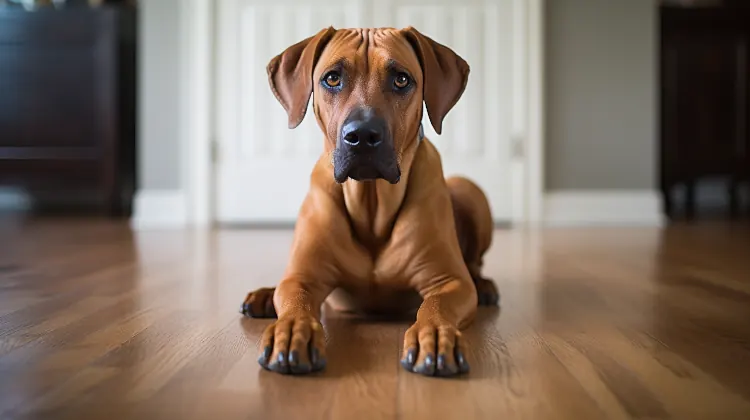Are you wondering when your Rhodesian Ridgeback will be fully grown? Look no further!
In this article, we’ll guide you through the growth timeline of Rhodesian Ridgebacks and answer all your questions.
From understanding if growth spurts are normal to determine the size range of these magnificent dogs, we’ve got you covered.
Plus, we’ll address whether neutering or spaying your Rhodesian Ridgeback will affect their growth.
Get ready for expert advice on when your furry friend reaches their full potential!
Key Takeaways
- Rhodesian Ridgebacks typically stop growing by 18 months of age.
- Males reach a height of 25-27 inches, while females grow to be around 24-26 inches tall.
- Rhodesian Ridgebacks typically weigh between 70 and 85 pounds, with males slightly heavier than females.
- Physical maturity is indicated by muscular development and body proportions matching breed standards.
Growth Timeline of Rhodesian Ridgebacks
By 18 months, your Rhodesian Ridgeback will have stopped growing and may experience additional muscle and fat build in the next few months. The average height of a male Rhodesian Ridgeback is between 25-27 inches (62-69 cm), while females typically grow to be around 24-26 inches (61-66 cm) tall.
Factors such as genetics play a crucial role in determining the final size of your Ridgeback. It is important to monitor your puppy’s growth by comparing its size to littermates and previous puppies from the same parents. Veterinary attention should be sought if there are any signs of illness, gait issues, or sudden extreme growth spurts.
To accurately measure your Ridgeback’s height, start at the ground and measure up to the withers, the highest point of their shoulder blades. This measurement method allows for accurate comparison across different breeds.
Is it normal for Rhodesian Ridgebacks to have growth spurts?
During their growth, you may experience periods where your Rhodesian Ridgeback has sudden bursts of growth. These growth spurts are a normal part of their development and can occur at various stages throughout their first two years. Causes of growth spurts in Rhodesian Ridgebacks can be attributed to genetics, nutrition, and hormonal changes.
It is important to manage these growth spurts properly to ensure your dog’s overall health. The impact of growth spurts on a Rhodesian Ridgeback’s health can include increased appetite, fatigue, and temporary joint discomfort as their bodies adjust to rapid growth. To support healthy growth during these periods, provide a balanced diet with appropriate nutrients and monitor exercise levels to prevent excessive strain on developing bones and joints.
Common concerns and questions about growth spurts in Rhodesian Ridgebacks include how long they last, if they are normal, and how much weight gain is expected. Remember to consult your veterinarian for personalized advice based on your dog’s needs.
Size Range of Rhodesian Ridgebacks
When adopting a Rhodesian Ridgeback, you can expect their size to range from 24 to 27 inches at the shoulder. Here are some key facts about their size:
-
Average weight: Rhodesian Ridgebacks typically weigh between 70 and 85 pounds, with males slightly heavier than females.
-
Height measurements: The height of a fully grown Rhodesian Ridgeback is measured at the shoulder, and it usually falls within the range mentioned earlier.
-
Growth rate: These dogs have a moderate growth rate, reaching their full height by around one-year-old. However, they continue to fill out and develop muscle until they are about two years old.
-
Genetic factors: Size can be influenced by genetic factors, so it’s important to consider the lineage of your Rhodesian Ridgeback when predicting its adult size.
To support healthy growth, provide them with a balanced diet that meets their nutritional needs. Regular exercise is also crucial for maintaining their overall health and fitness levels.
How can I tell if my Rhodesian Ridgeback is done growing?
You can tell if your Ridgeback is done growing by observing its physical development and muscle definition. As a responsible owner, it’s important to understand the signs of growth plate closure, which indicates that your Rhodesian Ridgeback has reached physical maturity. Additionally, comparing your dog’s size and weight to the breed standards can give you an idea if they have reached their full potential. Bone density determines when a Ridgeback is fully grown, directly affecting its overall structure and strength. It’s also worth noting that weight gain patterns may vary among individual dogs, so monitoring their growth over time can provide valuable insights into their maturation process. By closely examining these factors, you can determine when your beloved Ridgeback has finished growing.
| Factors | Indicators |
|---|---|
| Growth Plate Closure | No further increase in length of long bones |
| Physical Maturity | Muscular development and body proportions match breed standards |
| Breed Standards | Size and weight within the expected range for Rhodesian Ridgebacks |
| Bone Density | Strong and sturdy skeletal structure. |
Consult your veterinarian for any concerns or questions about your Rhodesian Ridgeback’s growth and development. They can provide expert advice tailored specifically for your furry friend.
Will Neutering/Spaying My Rhodesian Ridgeback Affect His Growth?
If you neuter your Rhodesian Ridgeback, it may impact their growth and development. The timing of neutering/spaying about growth is an essential factor to consider.
Here are four critical points about the impact of neutering/spaying on growth in Rhodesian Ridgebacks:
-
Muscle mass and body size: Neutering can reduce muscle mass and body size in males due to removing testosterone, a hormone essential for muscle development.
-
Factors influencing growth: Each dog is unique, so the effects of neutering cannot be guaranteed. Genetic factors, nutrition, exercise, and overall health also play significant roles in a dog’s growth.
-
Long-term effects: The long-term effects of neutering/spaying on body size are variable among dogs. While some may experience a noticeable difference, others may see little substantial changes.
-
Consideration for timing: It is generally recommended to wait until 18 months of age before considering neutering or spaying your Rhodesian Ridgeback to allow its body to develop fully.
Understanding these factors will help you make informed decisions regarding the impact of neutering/spaying on your Rhodesian Ridgeback’s growth and development.
FAQ’s
A: A Rhodesian Ridgeback is considered full grown when it reaches its adult size, typically between 1.5 to 2 years of age.
A: A Rhodesian Ridgeback growth chart is a chart that tracks the weight and height of a Rhodesian Ridgeback puppy as it grows. It can be used as a guide to monitor the puppy’s growth and development.
A: The weight of a Rhodesian Ridgeback puppy can vary, but on average, they weigh between 15 to 20 pounds at eight weeks old.
A: It is important to feed your Rhodesian Ridgeback puppy a high-quality dog food formulated for large breed puppies. This will provide them with the necessary nutrients for healthy growth.
A: Rhodesian Ridgebacks are a large breed of dog and typically reach a height of 24 to 27 inches at the shoulder and weigh between 70 to 85 pounds when fully grown.
A: Rhodesian Ridgebacks usually stop growing in height by around 1.5 to 2 years, but they may continue to gain weight and muscle mass until they reach their full adult size.
A: The average weight of a female Rhodesian Ridgeback is between 65 to 75 pounds.
A: Yes, a growth chart can be used to track the weight of your Rhodesian Ridgeback. It can help you monitor their growth and ensure they are gaining weight at a healthy rate.
A: Rhodesian Ridgebacks grow rapidly during their first year of life, with most of their growth occurring within the first 6 to 8 months.
A: A healthy weight for a Rhodesian Ridgeback can vary depending on their size and build, but on average, they should weigh between 70 and 85 pounds.
Conclusion
In conclusion, knowing when a Rhodesian Ridgeback is considered full grown is important for their overall care and development. Understanding this breed’s growth timeline, potential growth spurts, and size range can help determine if your dog has reached its adult size.
Additionally, it’s crucial to consider the effects of neutering or spaying on their growth. By staying knowledgeable about these factors, you can ensure that your Rhodesian Ridgeback reaches its full potential healthily and happily.





